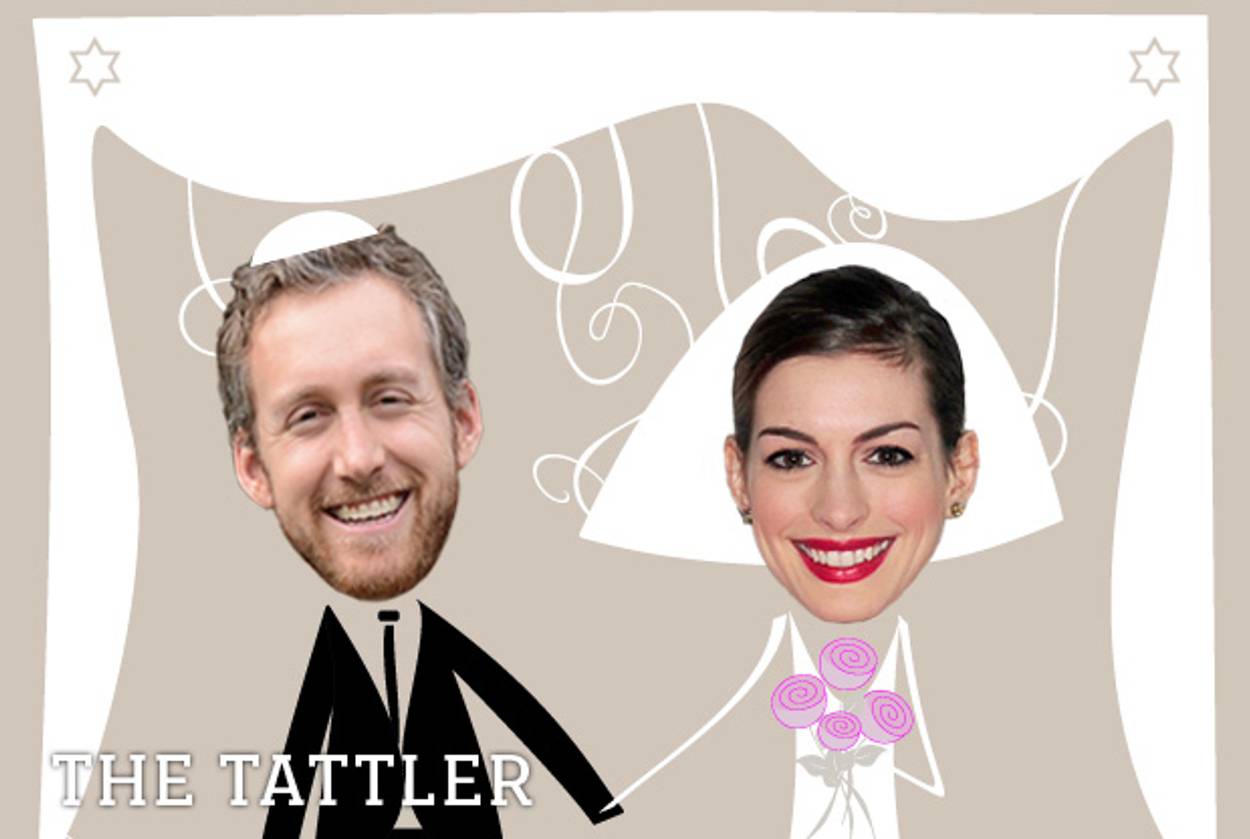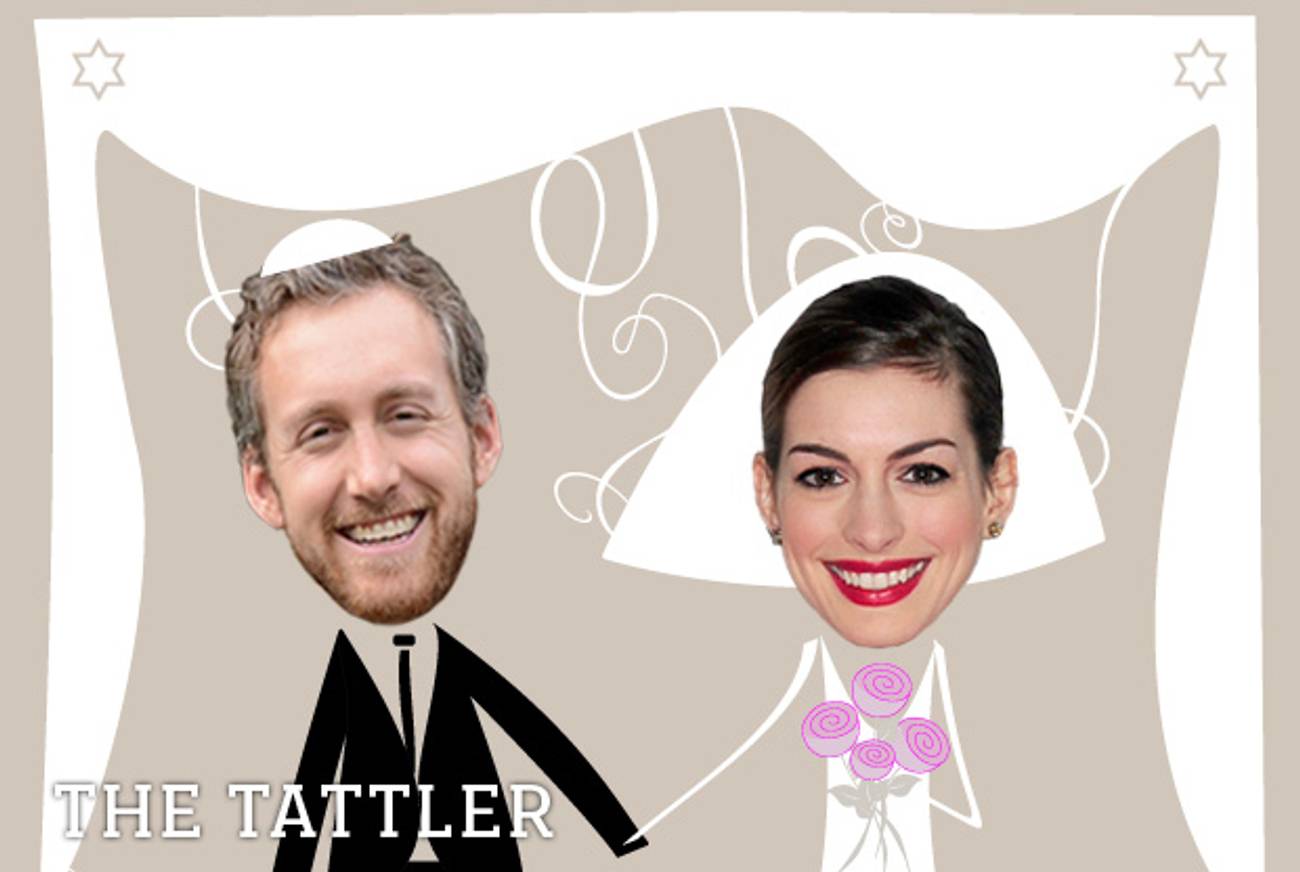Intermarried A-Listers and Us
Anne Hathaway’s and other celebrity weddings suggest that in America Jewishness has become aspirational




Mazel tov, Anne Hathaway!
For those of you who don’t read the tabloids or fit into the narrow Venn diagram sliver of people equally obsessed with Les Misérables and The Dark Knight Rises (even I fit into only one of those circles; I’ll let you guess which), allow me to inform you: The Devil Wears Prada star and patron saint of drama nerds married her fiancé Adam Shulman last weekend. The groom wore a suit; the bride, a custom-made Valentino confection with a headpiece that made her look like the world’s most ethereal lobotomy patient. They did it in Big Sur. And, as every tabloid has made clear, it was a “traditional Jewish ceremony.”
That makes the new Mr. and Mrs. Shulman—along with Drew Barrymore and her new husband Will Kopelman, son of former Chanel CEO Arie Kopelman (well done, Drew!) and Her Majesty Queen Natalie Portman and dancer/choreographer Benjamin Millepied—the third celebrity couple to wed under a chuppah this year, with all the ketubah ’n’ glass-smashing fixins, despite having one of the least traditional aspects of all: a partner who isn’t actually Jewish. Doubtless, in some circles this will be seen as a cause for much hand-wringing about the sorrowful state of the Jewish people, but I’m not so concerned. Intermarriage, like homosexuality, has been around since biblical times, and it isn’t going anywhere. If all the royal families of Europe put their crowned heads together and figured they could use some new blood, we could probably stand for some too.
For the first time in the history of America, Jewishness—and not just the bagels-and-lox part—is aspirational.
More interesting to me are the cultural ramifications of seeing a Hollywood princess awkwardly perched on an uplifted chair like she’s playing Tzeitel in her high-school production of Fiddler (which I’ll bet you a hundred bucks Anne Hathaway has done). These weddings all have one Jewish partner, after all; they aren’t some creepy, faintly Orientalist adoption of a culture based solely on its aesthetics, like Russell Brand and Katy Perry’s doomed Hindu union, the co-opting of the sacred rites of a religion to which you have no measurable connection, even if you do really like the idea of elephants in sequins. Or Britney Spears’ Moroccan-themed baby showers of yore. Or the fact that Mariah Carey actually named her kid “Moroccan,” although technically, this wasn’t after a denizen of the Maghreb but after the theme of the décor in one of the rooms of her house, which—I rest my case.
That’s not to say there isn’t some yearning for Zion realness here; as Madeleine Kahn said derisively in Betsy’s Wedding about the family of her daughter Molly Ringwald’s WASP-y fiancé: “They don’t even know what they are. He said, they think they’re Scottish.” Who wants a piece of stale white bread when they could have a nice big slice of rye?
And that’s precisely the point. The current vogue for Jewishness, in weddings or otherwise, is less notable for its exoticism—the kind of thing that might seem irresistibly “edgy” to a Crayola-haired pop star who uses that word a lot—than for its normalcy. When Drew Barrymore stands under a chuppah, or Anne Hathaway accompanies her fiancé to Yom Kippur services, or the husbands of Queen Natalie and her lady-in-waiting Rachel Weisz (and believe me, the thoughts I have about Daniel “James Bond” Craig as the ultimate trophy husband could fill a doctoral dissertation) slip on a yarmulke or wrap themselves in a tallis, they’re doing so because it’s normal, and the mainstream nature of the ritual is the key to its desirability. For the first time in the history of America, Jewishness—and not just the bagels-and-lox part—is aspirational. There’s a Seder in the White House, and rabbis gave the invocation at the conventions of both major political parties—something that would have been unthinkable as recently as my childhood, when I cried every year when we didn’t have a Christmas tree and told my friends the Friday night dinners I had to attend before I could go out were just “family nights.” Ralph Lauren built an empire giving us all WASP anxiety; now the WASPs want to be Jews.
There’s no telling how far this will go, or how long it last. Two decades from now, we may have been swept into the indistinguishable morass of white people, and a different kind of writer will be composing think pieces on how everybody now wants to pretend that they’re Indian. But in the meantime, if we see an artisanal gefilte fish movement start up in Brooklyn; if the generic wedding scene that opens every boilerplate romantic comedy features a reading from the Song of Solomon instead of Corinthians; if pageant moms in the South start naming their golden-headed little moppets things like Goldman and Silverberg because they think it sounds classy, I’ll be cheering them on. It won’t be proof that assimilation is evil. It’ll be proof that we can let others in without diminishing ourselves. It’ll be proof that assimilation works.
***
Like this article? Sign up for our Daily Digest to get Tablet Magazine’s new content in your inbox each morning.
Rachel Shukert, a Tablet Magazine columnist on pop culture, is the author of the memoirs Have You No Shame? and Everything Is Going To Be Great. Starstruck, the first in a series of three novels, is new from Random House. Her Twitter feed is @rachelshukert.
Rachel Shukert is the author of the memoirs Have You No Shame? and Everything Is Going To Be Great,and the novel Starstruck. She is the creator of the Netflix show The Baby-Sitters Club, and a writer on such series as GLOW and Supergirl. Her Twitter feed is @rachelshukert.